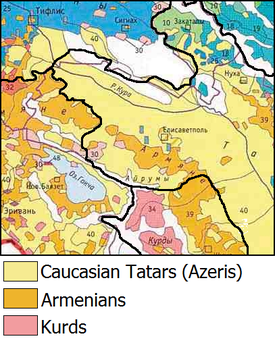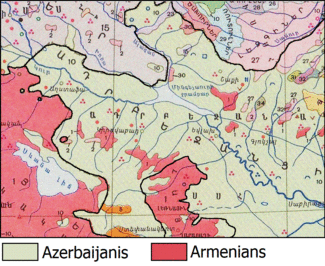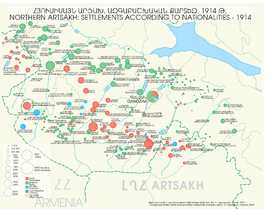- Northern Artsakh
-
 Ethnic map of the Northern Artsakh region (between Mrav Mountains and Kura River) in 1886-1890 with today's international borders and Nagorno-Karabakh de facto controlled territory frontier with Azerbaijan.
Ethnic map of the Northern Artsakh region (between Mrav Mountains and Kura River) in 1886-1890 with today's international borders and Nagorno-Karabakh de facto controlled territory frontier with Azerbaijan.
Northern Artsakh (Armenian: Հյուսիսային Արցախ, Hyusisayin Artsakh; less commonly mentioned as Lower Artsakh Armenian: Դաշտային Արցախ Dashtayin Artsakh) is a political concept used in the Republic of Armenia to refer the region in north-western Azerbaijan, lying north of Nagorno-Karabakh Republic (Mountainous Artsakh) and between the Kura river and the border of the Republic of Armenia, which had a significant Armenian population from antiquity up to the 1987-1992, when Nagorno-Karabakh conflict broke out.
Contents
History
Historically, the region was known as Gardman.[1] During the early medieval period, Northern Artsakh (it was more known under the name of Gardman in the Middle Ages) included some of the districts of Utik and Artsakh provinces of Greater Armenia, such as Koght, Kust-i-Parnes, Gardman, Shakashen, etc.
Under Russian Empire (1804-1918)
During the late medieval period, it formed part of Ganja khanate, being later incorporated into the territory of Russia, after which it became known under the name of Elisabethpol Governorate. During 1918-1920 period it was part of the Azerbaijan Democratic Republic.
August von Haxthausen, an ethnographer and an official from Prussia who visited Ganja in the 1850, writes:
“ Gandzak District is inhabited by the Armenians and the Tartars, the former dwelling in the mountains and the latter in the fertile plains. The Armenians are mainly engaged in farming and gardening (they grow wheat, barley, millet, maize and flax), while the Tartars' main occupation is stock-breeding: the majority of the latter is lazy but rich, whereas the former, on the contrary, are very hard-working. The Turkish villages are rather large, unlike the Armenian ones that comprise a small number of houses...[2] ” Soviet era (1920-1991)
 Ethnic map of the region in 1970, during Soviet era, showing Armenian (in red) enclaves outside of NKAO.
Ethnic map of the region in 1970, during Soviet era, showing Armenian (in red) enclaves outside of NKAO.
After the Soviet takeover, the region was annexed to the Republic of Azerbaijan, being divided into the following administrative units:
- Getabek (Кедабекский район)
- Dashkesan (Дашкесанский район)
- Touz (Таузский район)
- Khanlar (Ханларский район)
- Kasum-Ismayilov (Касум-Исмаиловский район)
- Ghazakh (Казахский район)
- Shamkhor (Шамхорский район)
- Shahumian (Шаумяновский район)
The following table shows the data from two Soviet censuses about the ethnic makeup of the region by districts (rayons) according to the 1939 and 1959 Soviet censuses.[3]
District 1939 1959 Armenians % Azeris % TOTAL Armenians % Azeris % TOTAL city of Ganja (Kiorvabad) 27,676 24 49,755 50.3 115,120 37,462 27.1 63,258 54.5 138,239 Shahumyan 12,048 85.9 429 3.1 14,032 12,707 77.2 2,744 16.7 16,459 Khanlar (Goygol) 27,316 63.5 9,191 21.4 43,050 16,845 51.7 13,063 40.1 32,592 Dashkesan 63 0.7 9,137 97.5 9,370 16,626 47.2 17,372 49.3 35,222 Shamkir 16,129 23.5 44,910 65.3 68,765 17,513 21.2 61,661 74.6 82,688 Goranboy 1,928 5.2 32,820 89.1 36,840 1,915 4.3 41,125 91.7 44,825 Tovuz 1,031 1.8 53,687 93.3 57,530 1,147 1.6 67,634 69.2 70,318 Qazax 824 2.2 34,846 93.6 37,220 700 1.7 40,290 95.5 42,185 Gadabay 442 1.2 31,950 83.9 38,100 294 0.6 48,320 91.1 53,047 8 districs and 1 city 87,457 20.8 216,970 63.5 420,027 105,209 20.4 292,209 68.9 515,575 Karabakh War and aftermath
See also: Operation RingDuring the Nagorno-Karabakh conflict, Northern Karabakh (Northern Artsakh) lost its remaining Armenian population.[4]
In May 1991, the Soviet sceurity forces (MVD and OMON) started the miitary Operation Ring in the region of Shahumyan, north of the Nagorno-Karabakh Autonomous Oblast of the Azerbaijan SSR. Officially dubbed a "passport checking operation", the stated goal launched by the Soviet Union's internal and defense ministries was to disarm Armenian militia detachments which were organized in "[illegally] armed formations."[5] The operation involved the use of soldiers who accompanied a complement of military vehicles, artillery and helicopter gunships to be used to root out the self-described Armenian fedayeen.
However, contrary to their stated objectives, Soviet troops and the predominantly Azeri soldiers in the OMON and army forcibly depopulated many Armenians living in the twenty-four villages strewn across Shahumyan to leave their homes and settle elsewhere in Nagorno-Karabakh or in the neighboring Armenian SSR.[6] Some authors have also described the actions of the joint Soviet and Azeri force as ethnic cleansing.[7]
Thus, the population of about 25 Armenian villages in Shahumyan and Khanlar districts (known to Armenians as Getashen and Martunashen) were deported to Armenia and NKAO.
Armenians of Shamkor and Dashkesan left their homes even before the military conflct started.
Republic of Azerbaijan
According to the 1999 Azeri official census, there were about 100 Armenians in the districts, known as Northern Arstakh: 32 in Ganja, 22 in Shamkir, 18 in Tovuzm 8 in Goranboy, 8 in Xanlar, 7 in Ağstafa, 7 in Gadabay, 6 in Dashkasan and 4 in Samux.[8]
See also
References
- ^ (Armenian) Ulubabyan, Bagrat. «Գարդման» (Gardman). Armenian Soviet Encyclopedia. vol. ii. Yerevan: Armenian Academy of Sciences, 1977, p. 700.
- ^ Baron August von Haxthausen, Studien über die innern Zustände, das Volksleben und insbesondere die ländlichen Einrichtungen Russlands, 1847-1852
- ^ (Russian) НАСЕЛЕНИЕ АЗЕРБАЙДЖАНА
- ^ The Annihilation of the Armenian Cemetery by Nakhijevan's Azerbaijani Authorities / Nakhijevan: A Historical Introduction, by Dr. Armen Haghnazarian, 2006, p. 5
- ^ De Waal, Thomas. Black Garden: Armenia and Azerbaijan Through Peace and War. New York: New York University Press, 2003, p. 114. ISBN 0-8147-1945-7.
- ^ De Waal. Black Garden, p. 120.
- ^ Melander, Erik in "State Manipulation or Nationalist Ambition" in The Role of the State in West Asia. Ed. Annika Rabo and Bo Utas. New York: I.B. Tauris, 2006, p. 173. ISBN 9-1868-8413-1.
- ^ Ethnic compostition of Azerbaijan 1999
- Northern Artsakh by Samvel Karapetyan
- La tutela del patrimonio culturale in caso di conflitto, edited by Fabio Maniscalco. 2002
- Samvel Karapetyan, Northern Artsakh, Yerevan: Gitutiun Publishing House, 2004 (re-published in 2007, ISBN 5808006775) - [1].
External links
Wikimedia Foundation. 2010.

